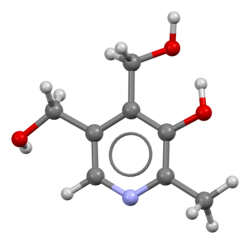Biology:Pyridoxine
 | |
 Pyridoxine | |
| Clinical data | |
|---|---|
| Other names | vitamin B6, pyridoxol[1] pyridoxine hydrochloride |
| AHFS/Drugs.com | Monograph |
| License data |
|
| Pregnancy category |
|
| Routes of administration | By mouth, intravenous (IV), intramuscular (IM), subcutaneous |
| ATC code | |
| Legal status | |
| Legal status |
|
| Identifiers | |
| |
| CAS Number | |
| DrugBank | |
| ChemSpider | |
| UNII | |
| KEGG | |
| ChEBI | |
| ChEMBL | |
| Chemical and physical data | |
| Formula | C8H11NO3 |
| Molar mass | 169.180 g·mol−1 |
| 3D model (JSmol) | |
| Melting point | 159 to 162 °C (318 to 324 °F) |
| |
| |
Pyridoxine, is a form of vitamin B6 found commonly in food and used as a dietary supplement. As a supplement it is used to treat and prevent pyridoxine deficiency, sideroblastic anaemia, pyridoxine-dependent epilepsy, certain metabolic disorders, side effects or complications of isoniazid use, and certain types of mushroom poisoning.[4] It is used by mouth or by injection.[4]
It is usually well tolerated.[4] Occasionally side effects include headache, numbness, and sleepiness.[4] Normal doses are safe during pregnancy and breastfeeding.[4] Pyridoxine is in the vitamin B family of vitamins.[4] It is required by the body to metabolise amino acids, carbohydrates, and lipids.[4] Sources in the diet include fruit, vegetables, and grain.[5]
Medical uses
As a treatment (oral or injection), it is used to treat or prevent pyridoxine deficiency, sideroblastic anaemia, pyridoxine-dependent epilepsy, certain metabolic disorders, side effects of isoniazid treatment and certain types of mushroom poisoning.[4] Isoniazid is an antibiotic used for the treatment of tuberculosis. Common side effect include numbness in the hands and feet.[6] Co-treatment with vitamin B6 alleviates the numbness.[7] Pyridoxine-dependent epilepsy is a type of rare infant epilepsy that does not improve with typical anti-seizure medications.[8]
Pyridoxine in combination with doxylamine is used as a treatment for morning sickness in pregnant women.[9]
Side effects
It is usually well tolerated, though overdose toxicity is possible.[4] Occasionally side effects include headache, numbness, and sleepiness.[4] Pyridoxine overdose can cause a peripheral sensory neuropathy characterized by poor coordination, numbness, and decreased sensation to touch, temperature, and vibration.[10] Healthy human blood levels of pyridoxine are 2.1 - 21.7 ng/mL. Normal doses are safe during pregnancy and breastfeeding.[4]
Mechanism
Pyridoxine is in the vitamin B family of vitamins.[4] It is required by the body to make amino acids, carbohydrates, and lipids.[4] Sources in the diet include fruit, vegetables, and grain.[5] It is also required for muscle phosphorylase activity associated with glycogen metabolism.
History
Pyridoxine was discovered in 1934, isolated in 1938, and first made in 1939.[11][12] It is on the World Health Organization's List of Essential Medicines.[13] Pyridoxine is available both as a generic medication and over the counter product.[4] Foods, such as breakfast cereal have pyridoxine added in some countries.[5]
References
- ↑ "Electrochemistry of Biologically Important Pyridines" (in en). Electrochemistry of Biological Molecules. Elsevier. 2012. p. 562. ISBN 9780323144520. https://books.google.com/books?id=N2FCSE3TGlgC&pg=PA562.
- ↑ "Pyridoxine Use During Pregnancy". 27 April 2020. https://www.drugs.com/pregnancy/pyridoxine.html.
- ↑ "Pyridoxine 50mg Tablets - Summary of Product Characteristics (SmPC)". 27 April 2015. https://www.medicines.org.uk/emc/medicine/28135/SPC/Pyridoxine+50mg+Tablets/.
- ↑ 4.00 4.01 4.02 4.03 4.04 4.05 4.06 4.07 4.08 4.09 4.10 4.11 4.12 4.13 "Pyridoxine Hydrochloride". The American Society of Health-System Pharmacists. https://www.drugs.com/monograph/pyridoxine-hydrochloride.html.
- ↑ 5.0 5.1 5.2 "Office of Dietary Supplements - Dietary Supplement Fact Sheet: Vitamin B6". 11 February 2016. https://ods.od.nih.gov/factsheets/VitaminB6-HealthProfessional/.
- ↑ "Isoniazid". The American Society of Health-System Pharmacists. https://www.drugs.com/monograph/isoniazid.html.
- ↑ "Pyridoxine in clinical toxicology: a review". European Journal of Emergency Medicine 12 (2): 78–85. April 2005. doi:10.1097/00063110-200504000-00007. PMID 15756083.
- ↑ "Management of pediatric status epilepticus". Current Treatment Options in Neurology 16 (7): 301. July 2014. doi:10.1007/s11940-014-0301-x. PMID 24909106.
- ↑ "Ginger on Human Health: A Comprehensive Systematic Review of 109 Randomized Controlled Trials". Nutrients 12 (1): 157. January 2020. doi:10.3390/nu12010157. PMID 31935866.
- ↑ "Pyridoxine deficiency and toxicity". MedLink Neurology. www.medlink.com. https://www.medlink.com/article/pyridoxine_deficiency_and_toxicity.
- ↑ (in en) The Role of Food, Agriculture, Forestry and Fisheries in Human Nutrition - Volume IV. EOLSS Publications. 2011. p. 121. ISBN 9781848261952. https://books.google.com/books?id=VJWoCwAAQBAJ&pg=PA121.
- ↑ Advances in Human Genetics 6. Springer Science & Business Media. 2012. p. 39. ISBN 9781461582649. https://books.google.com/books?id=UJ0KCAAAQBAJ&pg=PA39.
- ↑ World Health Organization model list of essential medicines: 21st list 2019. Geneva: World Health Organization. 2019. WHO/MVP/EMP/IAU/2019.06. License: CC BY-NC-SA 3.0 IGO.
External links
- "Pyridoxine". Drug Information Portal. U.S. National Library of Medicine. https://druginfo.nlm.nih.gov/drugportal/name/pyridoxine.
- Pyridoxine mass spectrum
pt:Piridoxina
 |

